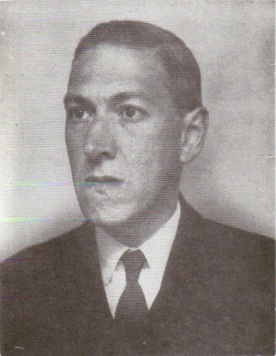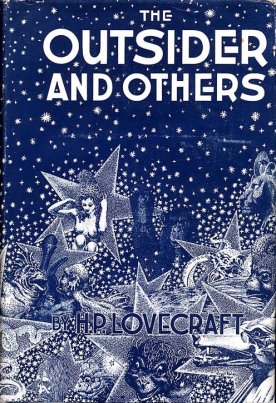In the history of fantasy writing and publishing, Milwaukee was for a brief time the “center of the craft,” but by then the end was already in sight.
Robert Bloch (1917-1994) was an American writer of fantasy, horror, and crime — the famous author of Psycho — who began his career in Wisconsin. As a teenager, he absorbed the fiction of H. P. Lovecraft (1890-1937), the author of supernatural horror and weird tales (perhaps the most significant of all time), affectionately referred to as HPL.

HPL: Portrait by Lucius B. Truesdell
Bloch turned 16 years old on April 5, 1933. He decided to write a letter to Lovecraft in care of the pulp magazine Weird Tales, where most of Lovecraft’s work was appearing. Probably the magazine’s editor, Farnsworth Wright, forwarded his message to Lovecraft, who was then living in Providence, Rhode Island.
On April 22, HPL wrote back to Bloch, “Your very flattering note has just been forwarded to me by Weird Tales…,” inaugurating an especially interesting, albeit brief, correspondence between the two. HPL generously answered Bloch’s frequent letters with lengthy missives of his own, in which he mentored the budding author and apprised him of literary news.
Lovecraft’s side of this cycle was published in 1993 by Necronomicon Press as H. P. Lovecraft Letters to Robert Bloch, edited by David E. Schultz and S. T. Joshi. Bloch’s side of this exchange probably no longer exists.
Excerpts from these Lovecraft letters will interest members of Allied Authors of Wisconsin because they shed light on the group’s earliest incarnation as the Milwaukee Fictioneers and should interest the fans of fantasy at large because they also reveal the sad dovetailing of events which brought to a close possibly the greatest era in the history of American fantastic writing.
Due in part to Lovecraft’s tutelage and encouragement, Bloch’s skills developed quickly, and he experienced early success selling short stories, including several published by Weird Tales. In 1935, now 18 years old, Bloch was subject of a feature article in Wisconsin’s largest newspaper, the Milwaukee Journal, in the nationally famous Green Sheet section. HPL wrote Bloch, “Let me congratulate you all over again on the vivid writeup…! It certainly presents you very strikingly & interestingly, & I don’t wonder at the messages & invitations it has brought you.”
One of these invitations is of especial interest because a week after appearing in the Green Sheet, Bloch was invited to join the Milwaukee Fictioneers.
Bloch may already have had other literary affiliations. HPL lauded the benefits of joining such groups, so his comments dated tentatively December 22, 1934 may not apply specifically to the Fictioneers, though they are revealing, nevertheless:
Your Tuesday evening discussion group sounds admirably interesting & stimulating. In a way — except for the nearly uniform ages, & the possibly greater systemization of topics — it reminds me of my old gang … We used to meet around at the different members’ houses & argue about everything under the sun… And did we have some swell intellectual free-for-alls on various aesthetic & philosophical subjects? I’ll tell the cockeyed world!
But there’s no question about reference in the following aside, written early in June of 1935:
The Fictioneers must be a highly interesting group — & the Farley meeting seems to have formed a decidedly red letter occasion. I would have enjoyed the caricature of Satrap Pharnabazus — though I will admit that the latter isn’t as consistently fatuous & conventional in his editorial policy as most of the stuffed shirts at the helms of the various pulp rags. The guest of honour, with his wide experience in adventurous quarters, was doubtless a particular hit with those who follow the ‘action’ ideal.
“Satrap Pharnabazus” (perhaps loosely based on the historical Pharnabazus, a Persian governor or “satrap” of Phrygia circa 413 B.C.) is the humorous appellation HPL used when referring to Farnsworth Wright, whose editing principles he usually deplored.
“Farley” refers to Fictioneer Roger Sherman Hoar, the mathematician, inventor, and state senator, who also authored “The Radio Man” series under the pseudonym Ralph Milne Farley.
The next mention of Fictioneers in a Lovecraft letter written to Bloch occurs circa July 1935:
Glad the Fictioneers continue on their triumphant course — the recent rural meeting must have been a festive event indeed! I’m greatly interested to hear of your meeting with Stanley G. Weinbaum, whose interplanetary tales were first pointed out to me this year. He is probably the only one of the pulp other-planeteers to escape the worst clichés of his province … Congratulations on your collaborative victory with him in the horseshoe tournament — over such learned & capable opponents!
Of course, the members of Allied Authors today recall Weinbaum as another of the predominately science fiction-oriented, early member of Fictioneers.
Unfortunately it wasn’t long after this letter that the first ominous hints of bad things happening turned up, gleaned from the line or two in which HPL acknowledged Bloch’s club activities. On September 19 of that same year, he wrote:
Sorry to hear that Weinbaum has been under the weather, & hope he may soon be fully on his feet again. Pleased to know that he likes some of my stuff.
And then on December 28:
I was surely sorry to learn of Weinbaum’s death — only a few brief months after I was first introduced to his refreshingly original work. I had become an especial fan of his … & now there will be no more stories of ‘Tweel’ & kindred marvels! … The fatal illness seems to have been very unusual, since cancer is certainly rare at thirty-three.
Tweel is the unforgettable alien creature from the classic “A Martian Odyssey” and “Valley of Dreams.”
But it is HPL’s observation about cancer that is particularly foreboding, for it is possible that he was himself, intermittingly and unknowingly, experiencing the earliest effects of his own cancer.
Weinbaum’s death was mourned by the SF community, and the Fictioneers quickly laid plans to honor him. On March 14, 1936, HPL wrote:
Hope the Weinbaum memorial volume will be a success — & that it will contain a good amount of his best work. I shall get a copy … it is surely a manifold pity that he couldn’t have lived longer.”
Unfortunately, the SF community would suffer another significant loss. In June, HPL wrote:
Since I began this bulletin I’ve had the most depressing & staggering message — a postcard with the report that good old Two-Gun has committed suicide! I seems incredible — I had a long normal letter from him dated May 13. He was worried about his mother’s health, but otherwise seemed quite all right. If the news is indeed true, it forms weird fiction’s worst blow since the passing of Whitehead in 1932.
And, sadly, it was true.
“Two-Gun” was Lovecraft’s appellation for Robert E. Howard, who was only 30 years old when he died but already hugely popular and influential as the author we regard today as the originator of the “sword and sorcery” subgenre of fantasy. Lovecraft and Howard’s six years of correspondence, published in 2009, fills 900 closely typed pages in two huge volumes.
Henry S. Whitehead was a fellow writer and another personal friend of Lovecraft, who had also passed away unexpectedly, shortly after he turned 50 years old.
The letters between HPL and Bloch continued, but the Fictioneers were mentioned only one more time, when on October 15, 1936, Lovecraft wrote perceptively:
Glad to hear of your recent sessions with fellow-writers. Milwaukee seems to be evolving into quite a centre of the craft. I’ve heard of Gallun — & believe I read something of his once which was rather good.
Ray Gallun, yet another Wisconsin author of SF, was an honored guest at one or more of the meetings held by the Fictioneers.
During these final exchanges, HPL mentions the only book of his own that would be published in his lifetime; it would feature a single, hitherto unpublished and somewhat lengthy “short story.” The Shadow Over Innsmouth, error-ridden and cheaply made, was a disappointment. And, even though 400 copies of the page-sheets were printed, the publisher could only afford binding 200, which he finally did sometime late in 1936. The rest were lost or destroyed.
HPL’s final letter to Bloch has been tentatively dated to January 25, 1937. Lovecraft died of cancer, only 46 years old, in March 1937.
Fifty-six years later, in his autobiography, Bloch wrote, “There were no words to adequately express my grief then and there are none now.”

Ironically, the Weinbaum memorial volume Dawn of Flame, a collection of his best work, had also just been published. It would share a fate similar to the Lovecraft book. Jack Chalker and Mark Owings, the authors of The Science-Fantasy Publishers: A Critical and Bibliographic History, attest “500 copies printed but only 250 were ever bound and the balance of the sheets were lost.”
Chalker adds this anecdote: “August Derleth recalled that he received his copy of this book and The Shadow Over Innsmouth within thirty days of each other, and they were still on his desk when, a few months later, word came of Lovecraft’s death.”
Derleth was another Wisconsin writer who corresponded with HPL and Bloch. Perhaps inspired by Milwaukee Fictioneers’ Dawn of Flame, he also published a “collected best” memorial volume in 1939 — arguably the most famous fantasy collection ever! — under the Arkham House imprint.
 It was The Outsider and Others, by H. P. Lovecraft.
It was The Outsider and Others, by H. P. Lovecraft.
Nor would it be long before Arkham published Bloch’s first collection of supernatural stories, 1945’s The Opener of the Way.
A new era was beginning.
Science fiction would emerge a full-fledged literary genre in the coming decades, with myriad subgenres of its own, supported by socially active fans. Not to be outdone in the annals, fantasy would benefit immensely (albeit after a slow start), following publication of J. R. R. Tolkien’s The Hobbit or There and Back Again, in September of 1937.
Despite writing full-time himself, Derleth’s decision to continue Arkham House publishing created the world’s most important specialty publisher of fantasy right here in Wisconsin, a template dozens of others would follow. And the Milwaukee Fictioneers-Allied Authors of Wisconsin would continue its SF bent, not only with Bloch, but with Ray Palmer, Fredric Brown and Art Tofte. Today’s active roster represents a majority of SF and fantasy writers.
Perhaps another new era is beginning…
John D. Haefele contributed this article.
© John D. Haefele. All rights reserved.

February 7th, 2015 at 10:24 am
Although I’ve been a member of this wonderful group for many years, much of the fascinating information here is completely new to me. John Haefele (archivist/historian/”archaeologist”) has done the group and literary scholarship a great service and deserves our thanks.
February 14th, 2015 at 10:12 am
Hey, John,
Just now got around to reading this excellent article. Yes, AA does have an interesting history/background.
And while I simply can’t get into zlovecraft, he was certainly a kind and gracious person to lock in with Bloch.
And yes, we probably have some new SF ground -breakers in our group. Truly sorry I can’t invest interest in their presumably splendid efforts.
Once a Grinch, always a Grinch.
Best,
TOM